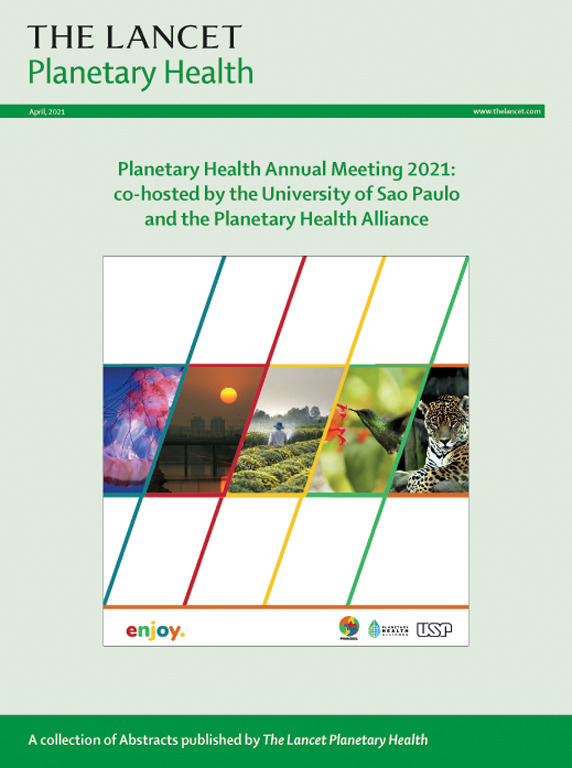解开人为气候变化、温室气体和气溶胶对英国热相关死亡率的贡献:气候变化影响归因研究
IF 21.6
1区 医学
Q1 ENVIRONMENTAL SCIENCES
引用次数: 0
摘要
背景人为气溶胶是造成气候变化的一个重要因素,其净冷却效应可以部分抵消温室气体的升温效应,但在气候变化的健康影响归因研究中却很少考虑它们。本研究的目的是将大不列颠与热有关的死亡归因于人为气候变化以及温室气体和气溶胶的个别作用力。方法利用一套特殊的气候模拟,在共享社会经济路径 SSP2-4.5 下估算了过去和未来大不列颠与热有关的死亡归因于人为温室气体和气溶胶作用力的相对贡献。结合气候模型和健康风险函数的不确定性,对经验置信区间进行了量化。研究结果与人为气候变化相关的热相关死亡率的出现被气溶胶的冷却效应部分抵消,与仅温室气体模拟相比,出现时间大约晚了 40 年。我们估计,1961-1980 年期间,每年约有 700 例与高温相关的死亡被气溶胶的冷却效应所掩盖。在温室气体增加和气溶胶大量减少的共同作用下,1980 年至 2020 年期间因高温死亡的人数急剧增加。到 21 世纪末,预计温室气体导致的高温死亡人数将增加 2-6 倍,而气溶胶的抵消作用微乎其微。这一点至关重要,因为它们对温度的影响截然相反,未来的排放轨迹各不相同,地理范围也各不相同。将气候变化影响分别归因于温室气体的全球效应和气溶胶的地方效应,可以提高透明度和公平性,并为损失和损害供资模型提供信息。这种影响归因评估有助于优化健康共同效益,防止环境政策对热相关和空气污染相关健康结果造成意想不到的负面影响。本文章由计算机程序翻译,如有差异,请以英文原文为准。
Disentangling the contributions of anthropogenic climate change, greenhouse gases, and aerosols to heat-related mortality in Great Britain: a climate change impact attribution study
Background
Anthropogenic aerosols are a critical contributor to climate change and their net cooling effects can partially counter the warming effects of greenhouse gases, but they are rarely considered in health impact attribution studies of climate change. The aim of this study was to attribute heat-related deaths in Great Britain to anthropogenic climate change and individual forcings of greenhouse gases and aerosols.
Methods
Using a special suite of climate simulations, past and future heat-related deaths in Great Britain attributable to the relative contributions of anthropogenic greenhouse gas and aerosol forcings were estimated under the Shared Socioeconomic Pathway SSP2-4.5. Empirical confidence intervals were quantified combining uncertainties from climate models and health risk functions.
Findings
Emergence of heat-related mortality associated with anthropogenic climate change was partially counteracted by the cooling effects of aerosols, with the time of emergence being approximately four decades later compared with the greenhouse gas-only simulation. We estimate that around 700 annual heat-related deaths during 1961–1980 were masked by the cooling effects of aerosols. There was a sharp increase in heat-deaths between 1980 and 2020 due to the combined effects of greenhouse gas increases and large aerosol reductions. By the end of the 21st century, a 2–6-fold increase in heat-related deaths due to greenhouse gases is projected, with a negligible counteracting contribution of aerosols.
Interpretation
In addition to greenhouse gases, the potential contributions of aerosols should be considered when assessing climate change risks and mitigation pathways. This is crucial due to their opposing temperature effects, diverging future emission trajectories, and varying geographical scales. Separate attribution of climate change impacts to the global effects of greenhouse gases and local effects of aerosols can enhance transparency and equity, and can inform loss and damage funding models. Such impact attribution assessments can help to optimise health co-benefits and prevent unintended negative consequences of environmental policies on heat-related and air pollution-related health outcomes.
Funding
Health Protection Research Unit in Environmental Change and Health, National Institute for Health and Care Research.
求助全文
通过发布文献求助,成功后即可免费获取论文全文。
去求助
来源期刊

Lancet Planetary Health
Multiple-
CiteScore
28.40
自引率
2.30%
发文量
272
审稿时长
8 weeks
期刊介绍:
The Lancet Planetary Health is a gold Open Access journal dedicated to investigating and addressing the multifaceted determinants of healthy human civilizations and their impact on natural systems. Positioned as a key player in sustainable development, the journal covers a broad, interdisciplinary scope, encompassing areas such as poverty, nutrition, gender equity, water and sanitation, energy, economic growth, industrialization, inequality, urbanization, human consumption and production, climate change, ocean health, land use, peace, and justice.
With a commitment to publishing high-quality research, comment, and correspondence, it aims to be the leading journal for sustainable development in the face of unprecedented dangers and threats.
 求助内容:
求助内容: 应助结果提醒方式:
应助结果提醒方式:


